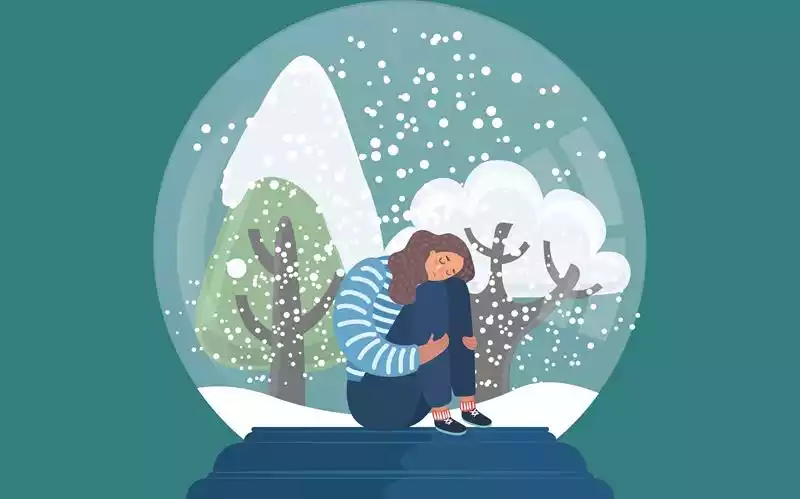Seasonal Affective Disorder and Depression are two distinct but often misunderstood mental health conditions. SAD is characterized by mood changes that follow a seasonal pattern, typically occurring during the fall and winter months. On the other hand, Depression, or Major Depressive Disorder, involves persistent low mood and a wide range of emotional, cognitive, and physical symptoms. Recognizing the differences between these disorders is crucial for accurate diagnosis and effective treatment.
Seasonal Affective Disorder

Seasonal Affective Disorder (SAD) is a type of mood disorder characterized by recurrent episodes of depression that occur at a specific time of year, typically during the fall and winter months when there is less natural sunlight. Anxiety disorder is commonly considered as the root of major depressive disorders.
People with SAD experience symptoms of depression, such as low mood, fatigue, changes in sleep and appetite, and decreased interest in activities, but these symptoms follow a seasonal pattern and tend to remit during the spring and summer months when sunlight exposure increases. The reduced exposure to natural light during the darker months is believed to contribute to the development of SAD by disrupting biological processes and neurotransmitter levels in the brain.
Causes of Seasonal Affective Disorder
Here are the key causes of Seasonal Affective Disorder (SAD):
- Reduced Sunlight Exposure:
- Less sunlight during fall and winter months.
- Decreased natural light affects body rhythms and neurotransmitters.
- Circadian Rhythm Disruption:
- Changes in daylight length disrupt the internal body clock.
- Impacts sleep patterns, mood regulation, and hormone release.
- Neurotransmitter Changes:
- Reduced sunlight may lower serotonin levels.
- Altered serotonin linked to mood disorders.
- Genetic Predisposition:
- Family history of mood disorders or SAD increases risk.
- Genetics play a role in susceptibility.
- Melatonin and Sleep Disturbances:
- Reduced light exposure disrupts melatonin production.
- Disrupted sleep patterns contribute to SAD symptoms.
- Geographical Location:
- Greater SAD prevalence farther from the equator.
- Sunlight variations between seasons affect susceptibility.
- Vitamin D and Hormonal Factors:
- Reduced sunlight reduces vitamin D synthesis.
- Vitamin D levels linked to mood regulation.
These causes interact and contribute to the unique features of SAD, particularly its seasonal pattern and symptoms.
Symptoms Seasonal Affective Disorder
The symptoms of Seasonal Affective Disorder (SAD) are similar to those of major depressive disorder, but they follow a specific seasonal pattern, typically occurring during the fall and winter months. The most common symptoms of SAD include:
-
- Depressed Mood: An overwhelming sense of sadness, emptyness, despair or emptiness.
- Low Energy: Decreased motivation and lack of energy, often leading to fatigue and difficulty initiating tasks.
- Changes in Sleep Patterns: Insomnia (difficulty falling asleep or staying asleep) or hypersomnia (excessive sleepiness and prolonged sleep).
- Appetite Changes: Increased cravings for carbohydrates and sugary foods, leading to weight gain in some cases.
- Weight Changes: Significant weight gain or loss due to changes in appetite and eating habits.
- Difficulty Concentrating: Reduced ability to focus, make decisions, and perform cognitive tasks.
- Loss of Interest: Once enjoyable pursuits no longer hold much interest or pleasure for us.
- Social Withdrawal: Avoidance of social interactions and decreased interest in socializing.
- Irritability: Heightened irritability and moodiness.
- Physical Symptoms: Physical discomfort such as body aches, headaches, and digestive issues.
- Feelings of Worthlessness: Negative self-perception, feelings of guilt, and low self-esteem.
- Suicidal Thoughts: In severe cases, thoughts of death or suicide may occur.
It’s important to note that the symptoms of SAD can vary in severity and may remit during the spring and summer months when there is increased sunlight exposure. If you or someone you know is experiencing these symptoms, especially if they interfere with daily functioning, seeking professional help from a mental health provider is recommended.
Depression

Depression, also known as Major Depressive Disorder (MDD), is a mental health condition characterized by persistent and pervasive feelings of sadness, emptiness, and a lack of interest or pleasure in activities that were once enjoyable.
It goes beyond normal fluctuations in mood and significantly interferes with daily functioning and overall well-being. Individuals with depression often experience a range of emotional, cognitive, and physical symptoms, including changes in appetite and sleep patterns, fatigue, difficulty concentrating, feelings of worthlessness or guilt, and Under pressure and stress, suicidal thoughts or attempts may arise.
Depression can be caused by a combination of genetic, neurochemical, environmental, and psychological factors, and it can affect people of all ages. It requires proper diagnosis and treatment, which may involve psychotherapy, medication, lifestyle changes, and support from mental health professionals.
Causes of Depression
Here are the causes of depression:
- Biological Factors:
- Neurotransmitter Imbalance (e.g., serotonin, dopamine)
- Brain Structure and Function Changes
- Hormonal Influences (e.g., cortisol)
- Genetic Predisposition:
- Family History of Depression
- Genetic Variations Linked to Susceptibility
- Psychological Factors:
- Negative Thought Patterns
- Low Self-Esteem and Negative Self-Perception
- Early Life Trauma or Adverse Events
- Environmental Factors:
- Stressful Life Events (e.g., loss, major changes)
- Social Isolation and Lack of Support
- Work or Academic Pressures
- Medical Conditions:
- Chronic Illnesses and Pain
- Certain Medications’ Side Effects
- Thyroid Disorders and Other Physical Health Issues
- Substance Abuse:
- Alcohol and Drug Use
- Substance Withdrawal
- Personality Traits:
- Perfectionism
- Self-Criticism
- Neurobiological Factors:
- Chronic Inflammation and Immune System Involvement
These factors can interact and contribute to the onset and development of depression. It’s important to consider a comprehensive approach when understanding and addressing the condition.
Symptoms of Depression
The symptoms of depression can vary in intensity and presentation, but they generally involve a persistent and pervasive low mood that significantly affects daily functioning and well-being. Below are the typical symptoms of depression:
-
- Depressed Mood: Persistence of feelings such as despair, hopelessness or an empty feeling are often associated with emotional suffering.
- Loss of Interest or Pleasure: Reduced interest or pleasure in activities that were once enjoyable.
- Fatigue: Feeling tired, low energy, and lacking motivation to engage in activities.
- Changes in Sleep Patterns: Insomnia (difficulty falling asleep or staying asleep) or hypersomnia (excessive sleepiness).
- Changes in Appetite or Weight: Changes in diet may result in weight gain or loss.
- Difficulty Concentrating: Inability to focus, make decisions, or think clearly.
- Feelings of Worthlessness or Guilt: Persistent feelings of inadequacy or guilt, often without reason.
- Physical Symptoms: Unexplained aches, pains, headaches, or digestive issues.
- Irritability: Easily getting agitated or frustrated, even over small matters.
- Social Withdrawal: Isolating oneself from social interactions and avoiding friends or family.
- Sleep Disturbances: Disrupted sleep patterns, including early morning awakening.
It’s important to note that someone with depression may not experience all of these symptoms, and the severity can vary. If these symptoms persist for more than two weeks and interfere with daily life, seeking professional help from a mental health provider is crucial. Depression is a treatable condition, and timely intervention can make a significant difference in recovery.
Comparative Table of Seasonal Affective Disorder and Depression
Here’s a comparative table highlighting the key differences between Seasonal Affective Disorder (SAD) and Depression:
| Aspect | Seasonal Affective Disorder (SAD) | Depression (Major Depressive Disorder) |
|---|---|---|
| Occurrence | Follows a seasonal pattern, often in fall/winter | Can occur at any time, not limited to seasons |
| Trigger | Reduced sunlight exposure | No specific external trigger |
| Symptoms | – Depressed mood during specific seasons
– Changes in sleep and appetite patterns – Social withdrawal – Low energy and decreased motivation – Weight gain and carbohydrate cravings (SAD) |
– Persistent low mood
– Loss of interest or pleasure in activities – Fatigue and decreased energy – Difficulty concentrating – Feelings of worthlessness or guilt |
| Duration | Remits during spring/summer months | Can persist for weeks, months, or years |
| Response to Seasons | Improved mood in spring/summer | Mood may not improve with seasons |
| Treatment Emphasis | Light therapy, exposure to sunlight | Psychotherapy, medication, lifestyle changes |
| Serotonin Impact | Reduced sunlight affects serotonin levels | Neurotransmitter imbalances often involved |
| Genetic Influence | Genetic predisposition might contribute | Strong genetic component |
| Geographical Variation | More prevalent in regions farther from the equator | Not tied to geographical location |
| Risk Factors | Seasonal changes, family history of SAD | Family history, stress, trauma, genetics |
Both SAD and Depression are complex conditions that can have overlapping symptoms and individual variations. If you or someone you know is experiencing symptoms of either disorder, seeking professional guidance is crucial for accurate diagnosis and appropriate treatment.
Similarities – Seasonal Affective Disorder and Depression
Here are the key similarities between Seasonal Affective Disorder (SAD) and Depression:
-
- Mood Changes: Both involve persistent low mood, often characterized by feelings of sadness, hopelessness, or emptiness.
- Physical Symptoms: Both can lead to changes in sleep patterns, appetite, energy levels, and physical discomfort.
- Cognitive Impairment: Both conditions can result in difficulties concentrating, making decisions, and cognitive fog.
- Social Withdrawal: Individuals with both disorders may isolate themselves and avoid social interactions.
- Impact on Functioning: Both significantly affect daily functioning, relationships, and overall well-being.
- Neurochemical Factors: Both conditions are associated with alterations in neurotransmitter levels that regulate mood.
- Treatment Approaches: Treatment often includes psychotherapy, medication, and lifestyle changes for both disorders.
- Overlap of Symptoms: Fatigue, concentration issues, sleep changes, and appetite alterations can occur in both conditions.
- Co-occurrence: SAD and Depression can sometimes coexist in individuals, making diagnosis complex.
While they share these similarities, the timing of symptoms (seasonal for SAD), the triggers, and light therapy as a distinct treatment approach for SAD set them apart. Accurate diagnosis by a healthcare professional is essential for appropriate management.
How to diagnose Seasonal Affective Disorder and Depression
Diagnosing Seasonal Affective Disorder (SAD) and Depression involves a thorough evaluation by a qualified mental health professional. Here’s an overview of the diagnostic process for each condition:
Diagnosing Seasonal Affective Disorder (SAD):
- Clinical Interview: A mental health provider conducts a detailed interview to gather information about the individual’s symptoms, medical history, and any seasonal patterns in their mood changes.
- DSM-5 Criteria: The clinician refers to the criteria outlined in the Diagnostic and Statistical Manual of Mental Disorders (DSM-5) to assess if the individual’s symptoms align with the diagnostic criteria for SAD.
- Seasonal Pattern: The provider evaluates whether the individual’s depressive symptoms consistently appear and remit with specific seasons, particularly during fall and winter when there’s reduced sunlight exposure.
- Duration and Severity: The symptoms must be present for a specific duration (e.g., two consecutive years) and significantly impact daily functioning.
- Exclusion of Other Conditions: The clinician rules out other potential causes of the symptoms, ensuring that SAD is the most fitting diagnosis.
- Physical Examination: A physical exam or medical tests might be conducted to exclude any underlying medical conditions.
- Sunlight Exposure History: Information about the individual’s exposure to sunlight during different seasons and any changes in their routines may be assessed.
Diagnosing Depression (Major Depressive Disorder):
- Clinical Interview: A mental health provider conducts an in-depth interview to gather information about the individual’s symptoms, emotional state, medical history, and personal experiences.
- DSM-5 Criteria: The clinician uses the DSM-5 criteria to determine if the individual’s symptoms meet the diagnostic criteria for Depression.
- Duration and Severity: The symptoms must be present for a specific duration (usually at least two weeks) and significantly affect the person’s daily functioning.
- Physical Symptoms: The provider evaluates the presence of physical symptoms like changes in sleep patterns, appetite, energy levels, and psychomotor activity.
- Exclusion of Other Conditions: Other possible causes of the symptoms, such as medical conditions or substance use, are ruled out.
- Suicidal Thoughts: The clinician assesses the presence and severity of any suicidal thoughts or behaviors.
- Questionnaires and Self-Reporting: The individual might be asked to complete standardized questionnaires that measure the severity and impact of their symptoms.
Remember that diagnosing these conditions requires professional expertise. If you or someone you know is experiencing symptoms of SAD or Depression, seeking guidance from a qualified mental health provider is crucial for accurate diagnosis and appropriate treatment.
Treatment Options for Seasonal Affective Disorder and Depression

Here’s a concise overview of treatment options for Seasonal Affective Disorder (SAD) and Depression:
Treatment for Seasonal Affective Disorder (SAD):
- Light Therapy (Phototherapy): Exposing oneself to bright artificial light that mimics natural sunlight, often in the morning, to regulate mood and circadian rhythms.
- Psychotherapy (Cognitive Behavioral Therapy – CBT): Identifying and changing negative thought patterns and behaviors associated with seasonal mood changes.
- Medication: Antidepressant medications may be prescribed, especially if symptoms are severe or significantly impact daily life.
- Lifestyle Changes: Increasing natural sunlight exposure, maintaining a consistent sleep schedule, engaging in physical activity, and managing stress.
Treatment for Depression (Major Depressive Disorder):
- Psychotherapy: Various types of therapy (e.g., CBT, Psychodynamic Therapy) to address negative thought patterns, explore underlying issues, and improve coping skills.
- Medication: Antidepressant medications, such as SSRIs or SNRIs, can help balance neurotransmitter levels and alleviate symptoms.
- Electroconvulsive Therapy (ECT): Reserved for severe, treatment-resistant cases, involving controlled electrical currents to induce a seizure for therapeutic effects.
- Transcranial Magnetic Stimulation (TMS): Non-invasive procedure using magnetic fields to stimulate brain cells, particularly for treatment-resistant depression.
- Lifestyle Adjustments: Regular physical activity, balanced diet, sufficient sleep, avoiding substance abuse, and stress management.
- Support Groups: Connecting with others facing similar challenges for emotional support and shared experiences.
- Mindfulness and Relaxation: Practices like meditation, deep breathing, and yoga to reduce stress and improve mood.
It’s important to consult with a mental health professional to determine the most suitable treatment plan based on individual symptoms and needs.
Impact on Daily Life and Relationships
Here’s a concise overview of how Seasonal Affective Disorder (SAD) and Depression can impact daily life and relationships:
Impact on Daily Life:
SAD:
- Reduced energy, altered sleep patterns
- Decreased productivity and motivation
- Changes in appetite, carbohydrate cravings
- Social withdrawal and decreased engagement
Depression:
- Fatigue, disrupted sleep
- Concentration issues, indecisiveness
- Appetite changes, weight fluctuations
- Loss of interest in activities, social withdrawal
Impact on Relationships:
SAD:
- Reduced social engagement, irritability
- Dependence on others for support
Depression:
- Social withdrawal, communication challenges
- Emotional strain on relationships
Understanding these impacts and seeking professional help can make a significant difference in managing symptoms and maintaining healthy relationships.
Self-Care Techniques
Self-care techniques play a crucial role in managing both Seasonal Affective Disorder (SAD) and Depression. Below are several self-care strategies which may assist:
For Seasonal Affective Disorder (SAD):
- Light Exposure: Spend time outdoors during daylight hours, especially in the morning. Alternatively, use light therapy lamps designed to mimic natural sunlight.
- Regular Routine: Maintain a consistent daily schedule, including regular sleep and meal times.
- Physical Activity: Take some form of physical activity every day – even if it means only short walks! Exercise can boost mood and energy levels.
- Healthy Eating: Consume a balanced diet with nutrient-rich foods. Avoid excessive sugar and refined carbohydrates.
- Social Engagement: Stay connected with friends and family, and engage in social activities you enjoy.
- Hobbies and Interests: Pursue hobbies that bring you joy and help take your mind off negative thoughts.
- Mindfulness and Relaxation: Practice relaxation techniques, deep breathing, meditation, and yoga to reduce stress.
For Depression (Major Depressive Disorder):
- Maintain Routine: Establish a daily routine to provide structure and stability to your day.
- Physical Activity: Engage in regular exercise, as it can help release endorphins and improve mood.
- Healthy Diet: Diets with adequate amounts of fruits, vegetables and whole grains as well as lean proteins and healthy fats tend to be healthy diets.
- Sleep Hygiene: Create an appropriate sleeping environment by following a regular sleeping schedule and following this tip for creating the best environment to rest peacefully at night.
- Limit Alcohol and Substance Use: Avoid or limit alcohol and substance use, as they can worsen depressive symptoms.
- Mindfulness and Relaxation: Practice mindfulness meditation, deep breathing exercises, and progressive muscle relaxation.
- Connect with Support: Reach out to friends, family, or support groups for emotional connection and understanding.
- Limit Stress: Identify sources of stress and find healthy ways to manage and reduce stressors.
- Set Achievable Goals: Break down tasks into smaller, achievable goals to create a sense of accomplishment.
- Express Yourself: Journaling, creative outlets, or talking about your feelings can help you process emotions.
Remember that self-care is an ongoing practice, and it’s important to tailor these techniques to your personal preferences and needs. If symptoms are severe or persistent, seeking professional help is crucial. A mental health provider can guide you in creating an effective self-care plan alongside appropriate treatments.
Final Opinion
Seasonal Affective Disorder highlights the significant influence of seasonal changes on our emotional well-being. By recognizing the distinct characteristics, exploring effective treatments, and embracing self-care strategies, individuals can navigate through the challenges posed by SAD and depression. Remember, seeking professional guidance and building a strong support network are crucial steps toward maintaining mental wellness throughout the year.



